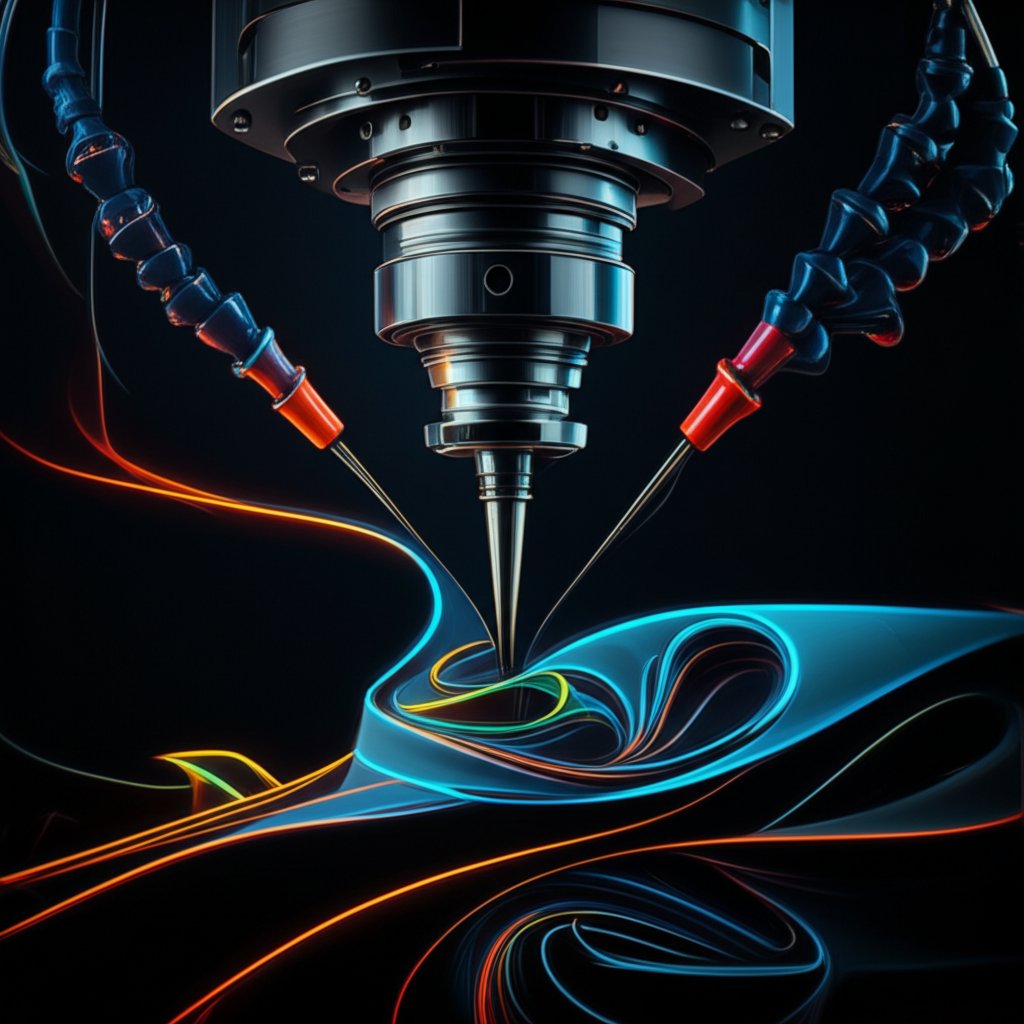Precision in Flight: Essentials of Aerospace CNC Machining

TL;DR
Aerospace CNC machining is a high-precision, computer-controlled manufacturing process used to create complex, critical components for aircraft and spacecraft. This method is indispensable for meeting the aerospace industry's stringent safety standards and extremely tight tolerances. By ensuring the exceptional accuracy and repeatability of parts, from engine components to structural supports, it guarantees the overall reliability and safety of flight systems.
Understanding CNC Machining and Its Critical Role in Aerospace
Computer Numerical Control (CNC) machining is a subtractive manufacturing process that uses pre-programmed computer software to dictate the movement of factory tools and machinery. In the context of the aerospace sector, it represents the pinnacle of precision engineering. This technology is not merely an option but a foundational requirement for an industry where safety and reliability are non-negotiable. It allows for the shaping of robust materials like titanium and aluminum alloys into intricate components with a level of accuracy that manual processes cannot achieve.
The critical role of CNC machining in aerospace is defined by its ability to meet and exceed the industry's rigorous demands. Every component, whether for an engine, airframe, or landing gear system, must adhere to strict specifications where even microscopic deviations can have catastrophic consequences. CNC machines can achieve tolerances as tight as 0.002 mm, ensuring that parts fit together perfectly and function flawlessly under extreme conditions such as high pressure, temperature variations, and intense vibrations. This precision directly translates to enhanced safety, improved fuel efficiency, and greater durability of the aircraft.
The importance of CNC machining in this field is underscored by several key factors:
- Precision and Accuracy: CNC systems deliver unparalleled accuracy, ensuring every part meets exact design specifications. This is vital for life-sustaining systems where component failure is not an option.
- Consistency and Repeatability: The automated nature of CNC machining ensures that every part produced is identical. This consistency is essential for manufacturing interchangeable components used in global aircraft fleets, simplifying maintenance and repair operations.
- Complexity and Design Freedom: Modern aircraft designs often feature complex geometries to optimize aerodynamics and reduce weight. Multi-axis CNC machines can produce intricate shapes, such as turbine blades and lightweight structural ribs, that would be impossible to create with other methods.
- Safety and Reliability: Ultimately, the precision and consistency of CNC machining contribute directly to the safety and reliability of aircraft. By eliminating human error and ensuring structural integrity, the process is fundamental to building trust in aerospace technology.

Key Applications and Components Produced
CNC machining is utilized across the entire spectrum of aerospace manufacturing, producing a vast range of components that are essential for the structure, propulsion, and operation of aircraft and spacecraft. The ability to work with high-strength, lightweight materials makes it the ideal process for parts that must withstand incredible stress while contributing minimally to the vehicle's overall weight. From the powerful engines to the detailed interior fittings, CNC-machined parts are ubiquitous.
The applications can be broadly categorized based on the section of the aircraft they serve. Each category has unique requirements for material properties, geometric complexity, and surface finish, all of which are managed through sophisticated CNC processes.
Engine and Powertrain Components
The jet engine is a masterpiece of complex, high-performance parts, many of which are produced using CNC machining. These components must endure extreme temperatures and rotational forces, demanding the use of superalloys like Inconel and titanium. Precision is paramount to maximize engine efficiency and reliability.
- Turbine and Compressor Blades: These parts feature complex airfoil geometries that must be machined to exact specifications to control airflow and generate thrust efficiently.
- Engine Casings and Housings: CNC machining creates strong, lightweight enclosures for engine components, ensuring they are protected and aligned correctly.
- Fuel Nozzles and Manifolds: Intricate internal channels for fuel delivery are precisely machined to ensure optimal combustion and engine performance.
Structural and Airframe Components
An aircraft's frame must be both incredibly strong and as light as possible. CNC machining is used to create structural components from large blocks of aluminum and titanium alloys, often removing significant amounts of material to create a strong but skeletal structure.
- Wing Spars and Ribs: These internal structures provide the wing's rigidity and shape, and are machined to precise dimensions to handle aerodynamic loads.
- Bulkheads and Fuselage Frames: These components form the primary structure of the aircraft body, requiring high strength and precise interfaces for assembly.
- Landing Gear Components: Parts like struts and beams must withstand the immense forces of takeoff and landing, demanding exceptional strength and fatigue resistance achieved through precision machining.
Avionics and Interior Components
While less structurally critical, the components housing an aircraft's electronic systems and furnishing its interior also benefit from CNC machining. Precision is necessary to ensure proper fit, function, and integration of complex systems.
- Avionics Enclosures: Housings for sensitive electronics are machined to provide electromagnetic shielding and protection from vibration.
- Support Brackets and Seat Tracks: Smaller interior parts are often machined from lightweight aluminum to hold larger assemblies together securely without adding unnecessary weight.
Advanced Aerospace CNC Machining Techniques
To meet the ever-increasing complexity and performance demands of modern aircraft, the aerospace industry relies on advanced CNC machining techniques. These methods go beyond standard 3-axis milling to produce parts with intricate geometries, superior surface finishes, and uncompromising accuracy. The evolution of these techniques has been a key enabler of innovation in aircraft design, allowing engineers to create lighter, stronger, and more efficient components.
Among the most significant advancements are multi-axis machining, multi-tasking machines (MTM), and high-speed machining (HSM). These technologies reduce production time, minimize the potential for errors, and expand the realm of what is manufacturable. For instance, services that offer rapid prototyping and DFM feedback, such as XTJ's formative manufacturing services, leverage these advanced capabilities to help accelerate product development cycles for the aerospace industry.
The distinction between 3-axis and 5-axis machining is particularly important. While 3-axis machines work on the X, Y, and Z planes, 5-axis machines add two rotational axes. This allows the cutting tool to approach the workpiece from any direction, enabling the creation of complex contours in a single setup. This capability is critical for parts like impellers and turbine blades.
| Feature | 3-Axis CNC Machining | 5-Axis CNC Machining |
|---|---|---|
| Part Complexity | Best for simpler geometries, flat profiles, and pockets. | Ideal for highly complex shapes, contoured surfaces, and undercuts. |
| Setup Time | May require multiple setups and repositioning for multi-sided parts. | Often completes a complex part in a single setup, reducing time and error risk. |
| Accuracy | High, but accuracy can be compromised with each manual repositioning. | Extremely high, as the part remains in one position for most or all operations. |
| Surface Finish | Good, but may show tool marks on contoured surfaces. | Superior, as the tool can maintain an optimal angle to the surface. |
| Common Applications | Brackets, housings, structural plates. | Turbine blades, impellers, complex airframe components. |
Essential Materials for Aerospace CNC Machining
Material selection in aerospace CNC machining is a critical decision driven by the extreme operational demands of the industry. Materials must offer a high strength-to-weight ratio, resistance to corrosion and fatigue, and stability at high temperatures. The choice of material directly impacts an aircraft's performance, fuel efficiency, and safety. CNC machining processes must be adapted to the unique properties of each material, as some high-performance alloys are notoriously difficult to machine.
The primary materials used fall into two main categories: lightweight metals and high-performance polymers. Metals like titanium and aluminum alloys form the backbone of most aircraft structures and engines due to their strength and durability. Meanwhile, advanced polymers are increasingly used in interiors and for specialized components where properties like electrical insulation or low friction are required.
Each material presents unique advantages and machining challenges. For example, titanium's strength and heat resistance make it ideal for engine parts, but its hardness causes rapid tool wear. Aluminum is lighter and easier to machine but cannot withstand the same temperatures as titanium. High-performance polymers like PEEK offer excellent chemical resistance and can replace metal in some applications to save weight.
| Material | Key Properties | Common Aerospace Applications |
|---|---|---|
| Titanium Alloys (e.g., Ti-6AL-4V) | High strength-to-weight ratio, excellent corrosion resistance, high-temperature performance. | Engine components (casings, blades), airframe structures, landing gear, fasteners. |
| Aluminum Alloys (e.g., 7075, 6061) | Lightweight, good strength, excellent machinability, cost-effective. | Fuselage frames, wing spars, structural parts, hydraulic systems. |
| Superalloys (e.g., Inconel) | Exceptional performance at extreme temperatures, high corrosion and oxidation resistance. | Turbine discs, combustion chambers, and other 'hot section' engine parts. |
| High-Performance Polymers (e.g., PEEK, ULTEM) | Lightweight, high chemical and temperature resistance, excellent dielectric strength. | Interior components, electrical insulators, bearings, seals. |

The Future of Precision in Aerospace Manufacturing
The trajectory of aerospace manufacturing is inextricably linked to the evolution of CNC machining. As the industry pushes towards greater sustainability, efficiency, and performance, CNC technology will continue to adapt and innovate. The integration of artificial intelligence (AI) and machine learning is set to optimize toolpaths in real-time, predict maintenance needs to reduce downtime, and ensure even higher levels of quality control. This move towards 'smart factories' and Industry 4.0 principles will further enhance the precision and productivity that define aerospace manufacturing.
Furthermore, the synergy between additive manufacturing (3D printing) and subtractive CNC machining is creating new possibilities. Hybrid manufacturing systems can build a near-net-shape part using 3D printing and then use CNC machining for the final critical finishing touches, combining the design freedom of additive with the precision of subtractive. This approach reduces material waste, a significant cost and environmental concern when working with expensive aerospace alloys. As new materials and aircraft concepts like electric vertical takeoff and landing (EVTOL) vehicles emerge, the flexibility and precision of CNC machining will remain essential to turning these futuristic designs into reality.
Frequently Asked Questions
1. What is CNC machining used for in the aerospace industry?
In the aerospace industry, CNC machining is used to produce a wide array of high-precision components. This includes critical engine parts like turbine blades and fuel nozzles, structural airframe components such as wing spars and bulkheads, landing gear systems, and avionics enclosures. The process is essential for creating complex parts from advanced materials that meet the industry's strict safety and performance standards.
2. Which CNC machine is best suited for high-precision aerospace components?
For high-precision aerospace components with complex geometries, 5-axis CNC machines are generally considered the best choice. Unlike 3-axis machines, 5-axis systems can move a part or tool along five different axes simultaneously. This capability allows for the machining of intricate shapes, such as those found on turbine blades or impellers, in a single setup. This reduces the risk of error from repositioning the workpiece and results in superior accuracy and surface finish.





